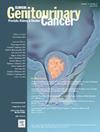免疫检查点抑制剂在晚期尿路上皮癌和组织学亚型患者中的应答和生存
IF 2.7
3区 医学
Q3 ONCOLOGY
引用次数: 0
摘要
免疫检查点抑制剂(ICIs)用于不同情况下的晚期尿路上皮癌(aUC)。大多数患者为纯UC (PUC),但约三分之一的UC伴有组织学亚型(HS)。我们检查了接受ICI治疗的HS aUC患者的预后。材料和方法我们纳入了来自26个中心的PUC和任何HS患者,这些患者接受ICI作为一线(1L)前期,维持性avelumab (mAV)和≥二线[2+L]治疗。我们从ICI开始计算总生存期和无进展生存期(OS, PFS)并观察缓解率(ORR)。结果纳入1511例患者;752 1L, 6092l, 150mav。1L: PUC患者(n = 518)的中位OS为15 (95% CI, 12-17)个月,鳞状UC患者(n = 85)为15 (95% CI, 8-23)个月(HR = 1.2, [95% CI, 0.8-1.6]),微乳头状UC患者(n = 46)为11 (95% CI, 6-17)个月(HR = 1.2, [95% CI, 0.8-1.8]), UC合并≥2 HS患者(n = 30)为21 (95% CI, 12-30)个月(HR = 0.9, [95% CI, 0.5-1.4])。2+L: PUC患者的中位OS为9 (95% CI, 8-10)个月(n = 441),鳞状UC患者的中位OS为9 (95% CI, 1-12)个月(n = 60) (HR = 1.1, (95% CI, 0.8-1.6)),微乳头状UC患者的中位OS为6 (95% CI, 1-11)个月(n = 37) (HR = 1.1, [95% 0.7-1.6]), UC合并≥2 HS患者的中位OS为7 (95% CI, 4-10)个月(HR = 1.6, [95% CI, 0.9-3.1])。结论采用ICI单药治疗aUC患者PUC与HS的OS无明显差异。局限性包括回顾性设计,几个子集的小样本量,缺乏随机化,没有中心成像或病理回顾,选择和混淆偏差。结果是假设产生的,需要前瞻性验证。本文章由计算机程序翻译,如有差异,请以英文原文为准。
Response and Survival With Immune Checkpoint Inhibitor in Patients With Advanced Urothelial Carcinoma and Histology Subtypes
Background
Immune Checkpoint Inhibitors (ICIs) are used for advanced urothelial carcinoma (aUC) in different settings. Most patients have pure UC (PUC) but about one-third have UC mixed with histology subtypes (HS). We examined outcomes in patients with HS aUC treated with ICI.
Materials and Methods
We included patients from 26 centers with PUC and any HS treated with ICI as 1st line (1L) upfront, maintenance avelumab (mAV), and ≥2nd line [2+L] therapy. We calculated overall and progression-free survival (OS, PFS) and observed response rate (ORR) from ICI start.
Results
We included 1511 patients; 752 1L, 609 2+L, 150 mAV. 1L: median OS was 15 (95% CI, 12-17) months for patients with PUC (n = 518), 15 (95% CI, 8-23) months for squamous UC (n = 85) (HR = 1.2, [95% CI, 0.8-1.6]), 11 (95% CI, 6-17) months for micropapillary UC (n = 46) (HR = 1.2, [95% 0.8-1.8]), and 21 (95% CI, 12-30) months in patients with UC mixed with ≥2 HS (n = 30), (HR = 0.9, [95% CI, 0.5-1.4]). 2+L: median OS was 9 (95% CI, 8-10) months for patients with PUC (n = 441), 9 (95% CI, 1-12) months for squamous UC (n = 60) (HR = 1.1, (95% CI, 0.8-1.6]), 6 (95% CI, 1-11) months for micropapillary UC (n = 37) (HR = 1.1, [95% 0.7-1.6]), and 7 (95% CI, 4-10) months in patients with UC mixed with ≥2 HS (n = 17), (HR = 1.6, [95% CI, 0.9-3.1]).
Conclusion
We found no significant OS difference between PUC and HS in patients with aUC treated with ICI monotherapy. Limitations include retrospective design, small sample size in several subsets, lack of randomization, no central imaging or pathology review, selection and confounding biases. Results are hypothesis-generating and need prospective validation.
求助全文
通过发布文献求助,成功后即可免费获取论文全文。
去求助
来源期刊

Clinical genitourinary cancer
医学-泌尿学与肾脏学
CiteScore
5.20
自引率
6.20%
发文量
201
审稿时长
54 days
期刊介绍:
Clinical Genitourinary Cancer is a peer-reviewed journal that publishes original articles describing various aspects of clinical and translational research in genitourinary cancers. Clinical Genitourinary Cancer is devoted to articles on detection, diagnosis, prevention, and treatment of genitourinary cancers. The main emphasis is on recent scientific developments in all areas related to genitourinary malignancies. Specific areas of interest include clinical research and mechanistic approaches; drug sensitivity and resistance; gene and antisense therapy; pathology, markers, and prognostic indicators; chemoprevention strategies; multimodality therapy; and integration of various approaches.
 求助内容:
求助内容: 应助结果提醒方式:
应助结果提醒方式:


